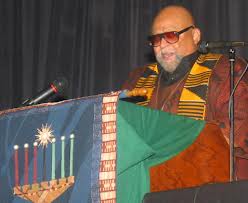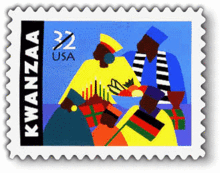Happy Kwanzaa!
Share
Explore Our Galleries
Breaking News!
Today's news and culture by Black and other reporters in the Black and mainstream media.
Ways to Support ABHM?
From Wikipedia
Kwanzaa is a week-long celebration held in the United States (and, more recently, Canada) but also celebrated in the Western African Diaspora.
The celebration honors African heritage in African-American culture, and is observed from December 26 to January 1, culminating in a feast and gift-giving. Kwanzaa was created by Dr. Maulana Karenga and was first celebrated in 1966-1967.
Kwanzaa celebrates what its founder called the seven principles of Kwanzaa, or Nguzo Saba (originally Nguzu Saba—the seven principles of African Heritage), which Dr. Karenga said “is a communitarian African philosophy,” consisting of what he called “the best of African thought and practice in constant exchange with the world.” These seven principles comprise Kawaida, a Swahili term for tradition and reason. Each of the seven days of Kwanzaa is dedicated to one of the following principles, as follows:

• Umoja (Unity): To strive for and to maintain unity in the family, community, nation, and race.
• Kujichagulia (Self-Determination): To define ourselves, name ourselves, create for ourselves, and speak for ourselves.
• Ujima (Collective Work and Responsibility): To build and maintain our community together and make our brothers’ and sisters’ problems our problems, and to solve them together.
• Ujamaa (Cooperative Economics): To build and maintain our own stores, shops, and other businesses and to profit from them together.
• Nia (Purpose): To make our collective vocation the building and developing of our community in order to restore our people to their traditional greatness.
• Kuumba (Creativity): To do always as much as we can, in the way we can, in order to leave our community more beautiful and beneficial than we inherited it.
• Imani (Faith): To believe with all our hearts in God, our people, our parents, our teachers, our leaders, and the righteousness and victory of our struggle.

Kwanzaa symbols include a decorative mat on which other symbols are placed, corn and other crops, a candle holder with seven candles, called a kinara, a communal cup for pouring libations, gifts, a poster of the seven principles, and a black, red, and green flag. The symbols were designed to convey the seven principles.
Read more about Kwanzaa and how it is celebrated, here.










Comments Are Welcome
Note: We moderate submissions in order to create a space for meaningful dialogue, a space where museum visitors – adults and youth –– can exchange informed, thoughtful, and relevant comments that add value to our exhibits.
Racial slurs, personal attacks, obscenity, profanity, and SHOUTING do not meet the above standard. Such comments are posted in the exhibit Hateful Speech. Commercial promotions, impersonations, and incoherent comments likewise fail to meet our goals, so will not be posted. Submissions longer than 120 words will be shortened.
See our full Comments Policy here.